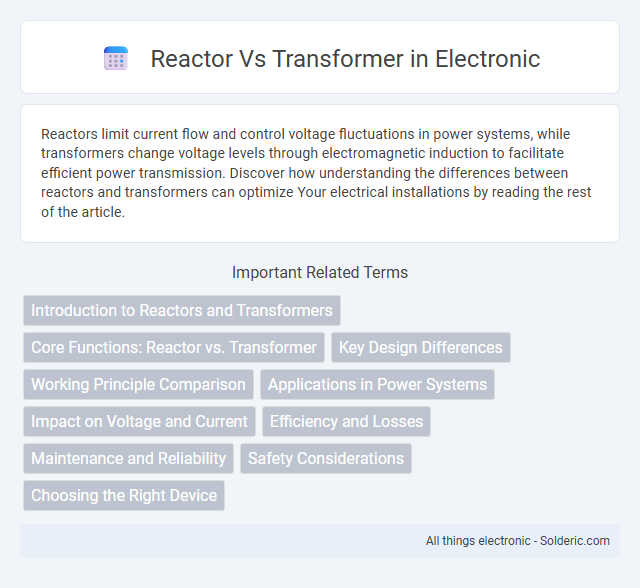Reactors limit current flow and control voltage fluctuations in power systems, while transformers change voltage levels through electromagnetic induction to facilitate efficient power transmission. Discover how understanding the differences between reactors and transformers can optimize Your electrical installations by reading the rest of the article.
Comparison Table
| Feature | Reactor | Transformer |
|---|---|---|
| Primary Function | Limits current, controls short circuit, filters harmonics | Transfers electrical energy via electromagnetic induction |
| Core Type | Air-core or iron-core | Iron-core or laminated steel core |
| Purpose | Current limiting and impedance control | Voltage stepping up or down |
| Energy Conversion | No energy conversion, only reactive power | Electrical energy conversion with minimal loss |
| Applications | Power system protection, harmonic filtering | Power distribution, voltage regulation |
| Voltage Transformation | No voltage change | Voltage step-up or step-down |
| Operating Frequency | High-frequency to power frequency | Power frequency (50/60 Hz) |
| Construction Complexity | Simple, fewer windings | Complex, multiple windings and taps |
Introduction to Reactors and Transformers
Reactors and transformers are essential components in electrical power systems, serving distinct functions within energy distribution and regulation. Reactors primarily manage current flow and voltage stability by providing inductive reactance, while transformers efficiently transfer energy between circuits through electromagnetic induction, often adjusting voltage levels. Understanding their operational principles and applications is critical for optimizing power system performance and ensuring electrical safety.
Core Functions: Reactor vs. Transformer
Reactors primarily function to limit current, control voltage, and filter harmonics in electrical circuits by providing inductive reactance. Transformers transfer electrical energy between circuits through electromagnetic induction, enabling voltage step-up or step-down while maintaining frequency. Unlike transformers, reactors do not provide voltage transformation but are essential for stabilizing power systems and reducing fault currents.
Key Design Differences
Reactors use inductive coils to oppose changes in current, providing impedance and limiting fault currents, while transformers transfer electrical energy between circuits via electromagnetic induction, often changing voltage levels. Reactors are designed with fewer windings and higher reactance, primarily for current limiting and filtering, whereas transformers have multiple windings with specific turns ratios to achieve voltage transformation. The core design of reactors emphasizes minimal magnetic losses and high impedance, contrasting with transformers that prioritize efficient energy transfer and voltage regulation.
Working Principle Comparison
Reactors operate on the principle of inductive reactance to limit current and control voltage by storing energy in a magnetic field, while transformers function by transferring electrical energy between circuits through electromagnetic induction with tightly coupled coils. The key difference lies in reactors having a single winding designed to impede current flow, whereas transformers have primary and secondary windings that step voltage up or down according to their turns ratio. Your choice between a reactor and transformer depends on whether you need current limitation and filtering or efficient voltage transformation and isolation.
Applications in Power Systems
Reactors are primarily used in power systems for limiting fault currents, controlling reactive power, and improving voltage stability by absorbing reactive energy. Transformers serve to change voltage levels efficiently for power transmission and distribution, enabling long-distance electricity transfer and ensuring compatibility between different parts of the grid. Both devices are essential for maintaining power quality and system reliability in high-voltage networks.
Impact on Voltage and Current
Reactors primarily limit current by introducing inductive reactance without significantly changing voltage levels, making them essential for controlling short-circuit currents and managing power quality. Transformers change voltage levels through electromagnetic induction, enabling efficient transmission and distribution by stepping voltage up or down while adjusting current proportionally. Understanding these differences is crucial for designing electrical systems that optimize voltage regulation and current flow.
Efficiency and Losses
Reactors generally have lower efficiency compared to transformers due to higher copper and core losses, as their primary function is impedance control rather than voltage transformation. Transformers are designed to efficiently transfer electrical energy between circuits with minimal losses, typically achieving efficiency levels above 98%. Losses in transformers are mainly core losses (hysteresis and eddy current) and copper losses, while reactors primarily experience resistive losses and magnetic losses that reduce their overall efficiency.
Maintenance and Reliability
Reactors require less frequent maintenance due to their simpler construction and fewer moving parts, enhancing operational reliability in power systems. Transformers, with complex insulation and cooling systems, demand regular inspections and oil testing to prevent failures and ensure longevity. Proper maintenance schedules for both components are critical to minimizing downtime and optimizing system stability in electrical networks.
Safety Considerations
Reactor and transformer safety considerations include managing overheating and electrical faults to prevent equipment damage and hazards. Reactors require proper cooling systems and protective relays to handle fault currents, while transformers need insulation maintenance and temperature monitoring to avoid oil leaks or fires. You must ensure regular inspections and compliance with electrical safety standards to protect both devices and personnel.
Choosing the Right Device
When choosing the right device between a reactor and a transformer, consider your application's primary needs: reactors are ideal for limiting short-circuit currents, controlling harmonic distortion, and providing inductive reactance, while transformers efficiently transfer electrical energy between circuits at different voltage levels. Your decision should factor in parameters like power rating, voltage requirements, impedance, and fault current levels to ensure optimal performance and safety. Accurately matching these characteristics helps maximize efficiency and prolong equipment lifespan in electrical systems.
reactor vs transformer Infographic

 solderic.com
solderic.com